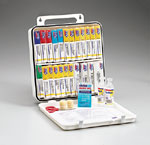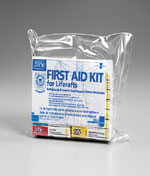Intro to Sea Survival | Life Rafts | Provisioning
Provisioning (cont.): Medical Kit and Supplies
MEDICAL KIT
Complete medical kits for boats are restricted by available space. Even more restrictions apply to the survival craft. The following section on medical supplies includes a reasonably extensive supply of ready-to-apply first aid and “final aid” items. It comprises what would be a basic “medical chest” for a boat.
The ship’s “medical chest” should be taken into the survival raft. Remember, if your ship goes down in a matter of minutes, you might have only enough time to launch your raft. For this reason, pack a condensed and smaller medical kit that is off limits for normal use and stored with your basic survival supplies. You can draw from the following list if you choose to package a survival medical kit.
Note: There are no quantities or dosages included in the following list. Quantities will, of course, depend on the number of crew normally aboard; obtain dosages from your physician.
Supplies
- Large plastic syringe, for stomach pump and aspiration
- Waterproof adhesive tape, (as opposed to bandages or pins for securing)
- Adhesive tape bandages
- Cotton wool
- Gauze (sterile and individually packed)
- Petroleum jelly
- Bandage, both cotton and absorbent types
- Inflatable splints
- Razor blades, (one edge) sealed against moisture
- Scalpels, various sizes
- Artery forceps
- Safety pins
- Scissors, 3-inch blades
- Hot water bottle with enema attachment and tube (stored elsewhere than the medical box)
- Snake-bite kit
- Tourniquet, 3/4 to 1 inch wide
- Thermometer, clinical with case
- Sling, cloth or muslin
- Tweezers
- Hypodermic syringe and needles
- Butterfly strips and bandages
- Sponge, sterile
- Suture circle needle
- Knife
- Waterproof adhesive dressing, assorted sizes
- Wire saw, for cutting through bones
- Jaw spreader and bite stick
- Stethoscope
- Iodine swabs
- Triangular bandage
- Eye pads
- Lip balm
- Flashlight
- First-aid instruction booklet
Discuss the medical kit with your physician to tailor it to your personal needs and to obtain any controlled sub stances. The controlled substances in your medical chest are your responsibility and must be protected against loss or abuse. (It is, however, not advisable to ever have the kit locked.)
The medical kit container should be large enough to include most of the medications needed, but still compact enough to be realistic for storage and handling. A plastic fishing tackle box, preferably watertight is excellent for this purpose. It allows for compact-ability, is corrosion proof, and provides assortment trays. Pack or sheath all pointed and sharp instruments to protect them from dam aging the raft and from exposure to the elements (shown below).


Above: Example of prepackaged Marine Medical and First-Aid
kits: Left:
192 piece, 24 unit United States Coast Guard approved lifeboat marine
first aid kit with plastic case is well equipped to handle all emergencies
common to commercial vessel workers. This marine first aid kit/boat first
aid kit includes a variety of bandages, compresses, and eye care, each
in its own double sealed waterproof pack for security out on the water. Right:
This 109 piece, 15 unit United States Coast Guard approved liferaft marine
first aid kit in waterproof bag is well equipped to handle all emergencies
common to commercial vessel workers. This marine first aid kit/boat first
aid kit includes a variety of bandages, compresses, and eye care, each
in its own double sealed waterproof pack for security out on the water.
Medications
The following list recommends a minimum number of possible medications to include in your medical kit:
- Ampicillin: a potent broad-spectrum antibiotic used for severe respiratory or kidney infections accompanied by high fever
- Gantrisin: for kidney and bladder infections
- Tetracycline: also a potent broad-spectrum antibiotic. Used as drug of first choice after penicillin for respiratory and skin infections
- Penicillin V.K.: the drug of first choice for respiratory infections, sore throats, and skin infections
- Procaine penicillin: injectable penicillin for infections that are fairly severe or for the patient who may be unable to hold down oral medicines because of vomiting
- Valium: an anti-anxiety drug also used for muscle relaxation. Will cause moderate to severe drowsiness
- Compazine: for prolonged vomiting (more than 24 hours)
- Empirin #3: pain medicine
- Morphine injection capsules
- Lomotil: anti-diarrheal medicine
- diphenhydramine hydrochloride: an antihistamine. Used for itching from rashes
- Alcohol (rubbing or isopropyl)
- Analgesic ointment: i.e., Lanocain, Nupercainal
- Meat tenderizer: for jellyfish stings.
- Neosporin
- Soap, Phisohex
- Sunburn ointment, sun screen
- Zinc oxide
- Adrenalin
- Antiseptic cream
- Motion seasickness pills. Include suppository or transdermal (through the skin) types for use in the event a victim is too ill to ingest a pill
- Acetaminophen, non-aspirin tablets
- White petroleum jelly
- Pepto-Bismol tablets
- Ammonia inhalants
PREV: Food Stores • NEXT: All About Signals • All Articles